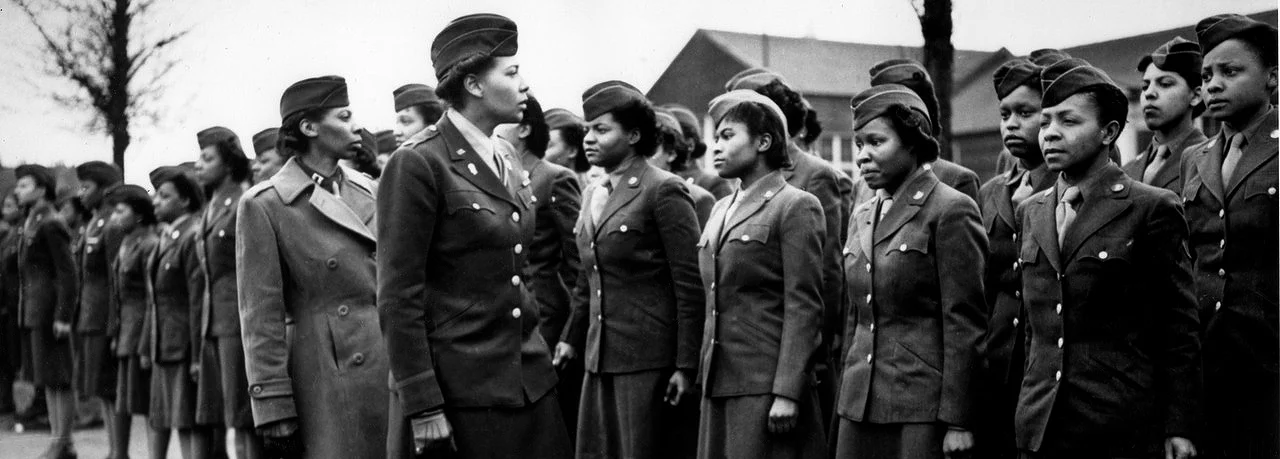
Soldiers of the 6888th Central Postal Directory Battalion give honor at the World War II memorial in New Orleans, Louisiana.
Photo credit: Buffalo Soldier Educational and Historical Committee. Public license.
The remarkable, less told story of ‘The Six Triple Eight’
The new Netflix film “The Six Triple Eight” recounts the World War II-era service of the only all-African American Women’s Army Corps (WAC) battalion sent overseas. The task was to sort seventeen million pieces of mail between soldiers and the home front. The 855 women of this battalion accomplished their task well under the six-month deadline. Others had been assigned the task. Only the 6888th accomplished it.
The film follows women newly enlisted in the WAC as they arrive at a training camp in the southern U.S., placed under the command of Major Charity Adams (portrayed here by the actor Kerry Washington). There, they face the rigors of physical training including learning how to endure a gas attack while deploying and wearing their gas masks for a long duration.
They also face the discrimination well documented by other female and BIPOC soldiers, past and present. The women train for high endurance, even while discounted by the military brass at all levels. Major Adams tells them, “A lot of people do not want us to succeed. We have the most to prove.”
Their commander keeps the battalion at the highest levels of rigor, as Adams already knows firsthand that her own hard-won promotions up the ranks still came without the respect other white soldiers would receive. Saluting their superior officer was not foremost on their mind when male soldiers (white or black) encountered Adams on base.
The resilience of the women serving in the 6888th is remarkable. Sent to England, the women work long hours, processing entire warehouses of mail, with some bloodied letters straight from the pockets of soldiers killed in battle. Even amid the onslaught of WWII, the racism and sexism encountered by the 6888th battalion seems insurmountable and downright overwhelming.
The lack of physical mail arriving today may seem a bit remote to generations now born into a hyperconnected world. The film shows the anguish of parents waiting anxiously by the mailbox back home, yearning for a letter from the front while dreading a notice of a soldier being killed, missing, or wounded far from home.
The ingenuity of the 6888th comes to the fore with their creative ways of overcoming smeared or illegible addresses. They read the mail for clues. For example, they gather a small collection of perfumes to sort out if a particular fragrance clues where a letter originated from the USA. (Perfumes were sold more regionally back then, making it easier to match a distinctive scent to help decode partial addresses further.)
How do we tell a fuller swath of history to the next generation, without falling into the habit of downsizing U.S. history into ever simplified narratives around heroism and achievement? What happens when those in power and dominant places in culture and politics become allergic to or threatened by the desire to respect history with nuance and complexity?
The film captures a moment in time less known in WWII history. Indeed, the story of the unit magnifies a thousandfold with this film, which draws from oral history from firsthand accounts and the limited available historical records. By comparison, when George Clooney adapted his film “Monuments Men” in 2014, he had far more primary and secondary sources to tap, as well as the industry clout to tell a story with a studio budget to match. Executive Producer of “The Six Triple Eight,” the prolific Tyler Perry, has developed his own cachet, yet he uses his capital (financial and influence) to invest frequently in stories many film studios still undervalue. (Indeed, the hashtag #OscarsSoWhite lingers for many lamentable reasons!)
I love films like “Monuments Men” and “The Six Triple Eight.” Both uplift elements of lesser-known stories during pivotal moments in history. However, the imbalance of which historical experiences are taught in classrooms, or the public square, is concerning.
How do we tell a fuller swath of history to the next generation, without falling into the habit of downsizing U.S. history into ever-simplified narratives around heroism and achievement? What happens when those in power and dominant places in culture and politics become allergic to or threatened by the desire to respect history with nuance and complexity? These latter tools are truly the best resources of an earnest historian, teacher, storyteller, and yes, even a preacher of the Gospel. Those who educate must not shrink from encouraging greater engagement of our history, and the ideas and myopias that are inextricable as part of it.
Policies like Manifest Destiny and various “America First” movements sound grand in their stated purposes, yet often, they encourage you to leave unquestioned the trampling of those in the way of their “onwards and upwards” approaches. Responsible engagement of U.S. history requires discomfort, reflectivity, and as needed, atonement.
The film does reflect such awareness, sharing in its endnotes about the people involved in the 6888th’s story, particularly in the renaming of an Army base. Originally named for Confederate General Robert E. Lee, who led the military effort against the United States in the U.S. Civil War, the base was renamed Fort Gregg-Adams in 2023 in honor of two highly decorated African American servicemembers: Lt. General Arthur James Gregg (1928-2024) and Lt. Colonel Charity Adams Earley (1918-2002).
The Rev. Jerrod H. Hugenot serves as the Associate Executive Minister for the American Baptist Churches of New York State.
The views expressed are those of the author and not necessarily those of American Baptist Home Mission Societies.



